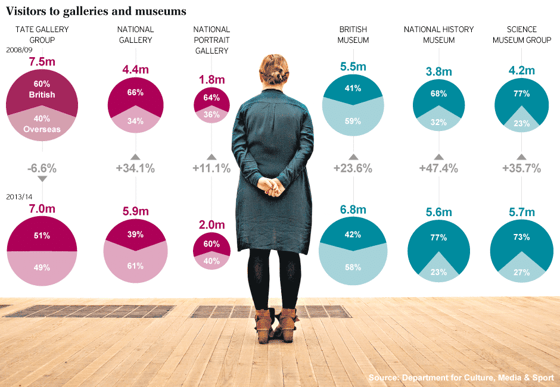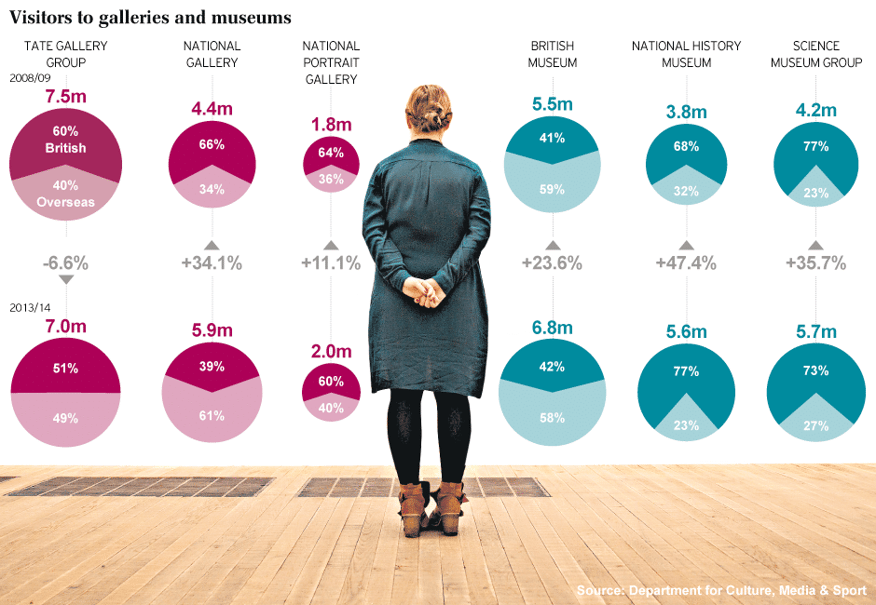


Marketing your art gallery for a footfall renaissance




Before you read on we have a question? Are you confident that your sales and marketing strategy is working?
If theres any doubt in your mind then use our free yet powerful comparison tool and get a full audit of your sales and marketing performance.
Marketing your gallery in a competitive space can be difficult. If you want some some solid information on how to do it right, read our blog "Marketing your art gallery online: Everything you need to know"
If you head over to the Department for Culture Media and Sport, you can get your hands on a cracking little spreadsheet that keeps a tally on visitor figures for the UK’s museums and galleries each and every month. It makes for interesting reading, especially for any art gallery marketing types.

Total visitor figures to Britain’s major museums and galleries are down from the previous year.2015/2016’s figures (yearly figures begin every April) are down on 2014/2015’s attendances. Most concerning to us though is the volatility of the monthly figures. For some months there’s a slight decrease – just under 18,000 people less visited galleries in July 2015/16 than in July 2014/15. There are some months where there is a huge plunge though. For instance, August saw 863,266 fewer people visiting museums and galleries than in the previous year.
We’re reminded of an article published in The Telegraph, which asked if we were falling out of love with art galleries. The piece was written at a time when visitor numbers were consistently very healthy. However, the footfall could be attributed more to foreign tourists than Britons visiting the cream of the nation’s galleries. If this is true, then marketing your art gallery should be a bigger priority than ever, particularly for local audiences.
Where art thou?
The Department for Culture Media and Sport's spreadsheet goes deeper still. It gives statistics for individual galleries to offer a new perspective on total visitor figures. If (as is the case) total visitor numbers are down, but a certain gallery has had a very positive month, then it can only mean that another gallery in the list – or a few of them – have had pretty bad months.
And that’s without even touching on museums and galleries that aren’t on the governments list. They range from established institutions to smaller, more niche galleries that promote local talent and tell stories of their region's history .
It’s not panic stations yet, though. If we were teachers grading this report on visitor numbers, it would be in ‘C’ territory. Art gallery marketing is definitely playing a part in attracting people. Nevertheless, more could be done to pique the interests of locals and get more people visiting on a consistent basis.
Short of running a costly PR campaign when a big event is on, galleries can’t do much more than push adverts online. Traditional means are the only way to try and catch people’s interest, surely?
Not at all. Marketing an art gallery can consist of many activities which can alert potential visitors to existing and upcoming attractions. In our mind, these activities should stem from an inbound campaign that’s cost-effective, creative and targeted to the right people.
Marketing your art gallery
A lot of galleries are using inbound theory and tactics already. This can include encouraging visitors to leave their email addresses with you after a visit. This means you can reach out to them at a later date and let them know about upcoming exhibitions. Brilliant; but is it enough, when there are so many other inbound-specific tools available to cultivate and communicate with your target audience? It’s a start, at least. And, thanks to the ever-evolving nature of the internet, there are a huge amount of inbound techniques that galleries and museums can tailor to their audience, and use to interact with them on a personal level.
For instance, introducing biddable social into your art gallery marketing strategy can enhance the way you incentivise your conversations. This means that you can give your audience more reasons to visit your gallery. Twitter has recently released a new biddable feature called ‘conversational ads’ which aims to help companies ignite conversations and debates amongst their target audience. They’re similar to promoted tweets but with a key difference. Calls to action use customisable hashtags to push what Twitter labels ‘earned media,’ resulting in a higher ROI.
So how would that help you in marketing your art gallery? A quick, simple example would be to target people with a fun debate such as ‘Who had the best cultural impact? #ArtistX or #ArtistY’. Give people the option to choose and discuss with others. The right strategy will also link discussions in with existing and upcoming events and exhibits to raise awareness.
Canvassing your audience
The gallery space is in a unique position. It functions in a creative industry which can easily stir comment and debate on a number of levels. Topics can range from what constitutes a piece of art, to experiences with pieces that people love or hate, how art has affected different cultures throughout history, the lifestyles of popular artists living and dead – and much more besides.
From deep discussion to simple interactions, you could begin marketing your art gallery by broaching these topics with targeted audiences on Twitter and other biddable social platforms. Twitter is the perfect way to strike up a conversation. Instagram though – as well as also reaching people immediately – attracts a younger audience in a highly visual way. What better way to promote physical, visual exhibits?
Instagram is perfect for producing creative targeted visual campaigns and is helping a lot of advertisers reach new audiences. Sounds ideal for any art gallery marketing strategy! The platform's success is impressive, especially considering people have only been able to advertise on Instagram since August 2015. Part of its success is because Instagram is Facebook-owned, meaning users can integrate pre-existing, successful campaigns over to Instagram.
That’s a huge deal; the right strategy will cultivate an audience on Facebook and attract them with a complemented biddable and visual Instagram campaign.
Using beacons for next-generation art gallery marketing
We mentioned before how inbound techniques are constantly evolving, and Facebook is a platform at the forefront of such change. Facebook Bluetooth beacons can also go a long way in marketing your art gallery and enhancing the visitor experience.
Beacons are free and can be placed around certain points of an art gallery, customised to send creative content to visitors' phones and engage with them. For instance, visitors looking at a specific piece of art could receive fun, short photos or videos about the artist. Better yet, people can share their own content and experience with others. This means they are effectively marketing your art gallery for you by creating an archive of user-generated content. It’s something that’s been used before, and it's an incredible way to enhance the user experience. For instance, when the giant puppets last visited Liverpool, beacons were placed along the route.
This is just one of the more creative possibilities for marketing your art gallery. Use a strong inbound strategy to attract new users and increase their footfall, and attract, inform, educate, and entertain the right local audience.
Marketing your art gallery can be difficult, but it's more important than ever to promote your artists and differentiate yourself from the competition.
If Art Gallery Marketing interests you then you can find out more by clicking here...
Marketing your gallery in a competitive space can be difficult. If you want some some solid information on how to do it right, read our blog "Marketing your art gallery online: Everything you need to know"







